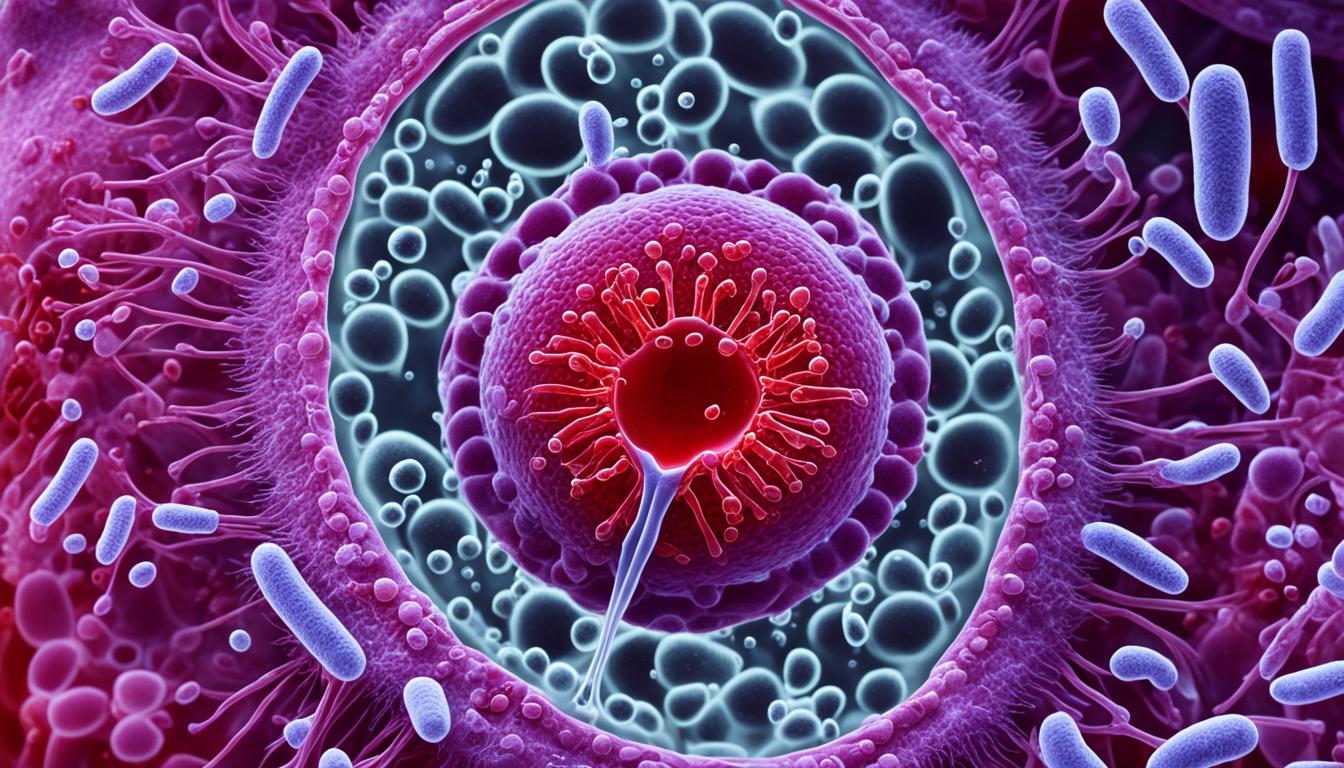Cystitis is a common infection in the urinary tract. It brings painful urination, bladder issues, and inflammation. It can come from bacteria, bladder harm, or other health conditions. Doctors find the cause by looking at urine, doing tests, and checking the bladder with images.
In the past, cystitis was fixed with antibiotics and help for the pain. But now, we’re looking at a new helper for this problem – stem cells. Stem cells can fix the body by growing new healthy tissue. Studies in animals show this might work well. Now, people are studying if it’s safe and useful for humans, too.
Stem cell therapy treats the root of cystitis, not just the symptoms. It aims to fix the bladder tissue that’s been hurt. For patients, this could mean a big change. They might feel better for a long time. This new way of healing could be a game-changer for cystitis treatment.
Key Takeaways:
- Cystitis causes painful urination and bladder issues.
- It can happen due to a bacteria, bladder harm, or other health problems.
- To find out what’s causing it, doctors check the urine and look at the bladder with tests.
- The usual treatments are antibiotics and pain relief medicines.
- But stem cell therapy is a hopeful new way to fix cystitis by growing new healthy bladder tissue.
Understanding Interstitial Cystitis/Bladder Pain Syndrome (IC/BPS)
Interstitial cystitis, also known as bladder pain syndrome (IC/BPS), causes chronic pelvic pain. It also leads to pressure or discomfort linked to the filling of the bladder. People with IC/BPS often feel the need to urinate more during the day or at night.
The condition’s exact cause remains a mystery, but it’s linked to bladder inflammation. This inflammation can start due to different reasons, like mast cells and problems within the bladder’s tissue. Studies have found issues in the urothelial glycosaminoglycan (GAG) layer of IC/BPS patients. This layer protects the bladder and stops harmful bacteria from sticking.
In certain instances, IC/BPS shows specific signs in the bladder, such as Hunner’s lesions. These lesions look like red spots with blood vessels leading to a central scar. They add to the long-term pelvic pain people with IC/BPS feel.
Remember, IC/BPS shows up differently in people. Some may not have severe symptoms and can be helped by changing their lifestyle. However, others might need more focused treatments.
Common Symptoms of IC/BPS:
- Suprapubic pain, discomfort, or pressure related to bladder filling
- Increased daytime or nighttime frequency of urination
- Chronic pelvic pain
Treatment Approaches for IC/BPS:
To tackle IC/BPS, treatments aim to ease symptoms, lessen pain, and better the patient’s life quality. This often involves many methods:
- Medications: Doctors might prescribe oral meds to reduce pain and bladder inflammation. For some, injecting meds into the bladder directly can help.
- Lifestyle modifications: It’s advised to steer clear of foods and drinks that may worsen symptoms. Stress management and specific exercises can also help.
- Bladder training: This method guides patients to wait longer between bathroom trips, increasing their bladder’s holding ability.
- Physical therapy: Special exercises and techniques can ease pelvic pain and boost muscle function.
- Bladder instillations: Sometimes, applying a mixture of certain substances directly to the bladder can soothe pain and inflammation.
For those with IC/BPS, it’s key to team up with healthcare providers. Together, they can craft a treatment plan that meets the patient’s specific needs and targets.
Stem Cell Therapy for Cystitis: Potential and Challenges
Regenerative medicine is exploring new ways to treat cystitis. It’s a condition that causes the bladder to swell and hurt. Stem cell therapy, especially using MSCs, looks very promising. It works by encouraging the bladder to heal and reduce symptoms.
Platelet growth factors, like PRP, are also making a difference in regenerative medicine. They help heal tissues. When mixed with stem cell therapy, they can boost the healing process. This could mean better results for those with cystitis.
But, stem cell therapy for cystitis is still new. Challenges need to be tackled. Studying it more will help unlock the full potential. We need to understand how stem cells help the bladder get better.
Setting standards for these treatments is key for their success. When we have clear rules, we can ensure the treatments are safe and work well. This means doctors can offer these therapies with confidence.
Even with hurdles to jump, stem cell therapy for cystitis is exciting. It offers hope for a better way to treat the condition. More research and improvements may make it a powerful solution. This could mean a brighter future for those with cystitis.

